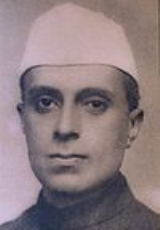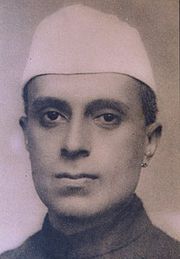
Gandhi cap
Encyclopedia

Khadi
The term khādī or khaddar means cotton. khādī is Indian handspun and hand-woven cloth. The raw materials may be cotton, silk, or wool, which are spun into threads on a spinning wheel called a charkha. It is a versatile fabric, cool in the summer and warm in the winter...
. It takes its name after the India
India
India , officially the Republic of India , is a country in South Asia. It is the seventh-largest country by geographical area, the second-most populous country with over 1.2 billion people, and the most populous democracy in the world...
n leader Mahatma Gandhi
Mahatma Gandhi
Mohandas Karamchand Gandhi , pronounced . 2 October 1869 – 30 January 1948) was the pre-eminent political and ideological leader of India during the Indian independence movement...
, who first popularised its use during the Indian independence movement
Indian independence movement
The term Indian independence movement encompasses a wide area of political organisations, philosophies, and movements which had the common aim of ending first British East India Company rule, and then British imperial authority, in parts of South Asia...
. Worn commonly by Indian independence activists
Indian independence activists
This is a listing of people who campaigned against or are considered to have campaigned against foreign domination and cultural imposition on the Indian sub-continent...
, it became a symbolic tradition for politicians and political activists to wear it in independent India.
Genesis
Caps of similar design and material have been worn throughout history by the people of Gujarat, Uttar PradeshUttar Pradesh
Uttar Pradesh abbreviation U.P. , is a state located in the northern part of India. With a population of over 200 million people, it is India's most populous state, as well as the world's most populous sub-national entity...
, Rajasthan
Rajasthan
Rājasthān the land of Rajasthanis, , is the largest state of the Republic of India by area. It is located in the northwest of India. It encompasses most of the area of the large, inhospitable Great Indian Desert , which has an edge paralleling the Sutlej-Indus river valley along its border with...
, Bihar
Bihar
Bihar is a state in eastern India. It is the 12th largest state in terms of geographical size at and 3rd largest by population. Almost 58% of Biharis are below the age of 25, which is the highest proportion in India....
, West Bengal
West Bengal
West Bengal is a state in the eastern region of India and is the nation's fourth-most populous. It is also the seventh-most populous sub-national entity in the world, with over 91 million inhabitants. A major agricultural producer, West Bengal is the sixth-largest contributor to India's GDP...
, Maharashtra
Maharashtra
Maharashtra is a state located in India. It is the second most populous after Uttar Pradesh and third largest state by area in India...
, Karnataka
Karnataka
Karnataka , the land of the Kannadigas, is a state in South West India. It was created on 1 November 1956, with the passing of the States Reorganisation Act and this day is annually celebrated as Karnataka Rajyotsava...
and other parts of India. Such caps are still worn by a large segment of Indian society without any political significance. The cap gained significance after it was regularly donned by Gandhi, whose popularity was rising fast. Gandhi's homespun khadi attire of traditional Indian clothes were symbolic of his message of cultural pride, the use of Swadeshi goods (as opposed to those manufactured in Europe), self-reliance and solidarity with India's rural masses. The cap became common to most followers of Gandhi and members of the Indian National Congress
Indian National Congress
The Indian National Congress is one of the two major political parties in India, the other being the Bharatiya Janata Party. It is the largest and one of the oldest democratic political parties in the world. The party's modern liberal platform is largely considered center-left in the Indian...
. A connection to the independence movement was implied when any individual wore the cap in those times.
Prisoners in South African prisons classified as "negroes" (a category into which Indians fell while Gandhi was in South Africa) also were required to wear similar caps in prison. Gandhi's close friend Henry Polak cites Gandhi's time in South African jail, where he was classified as a "negro" and thus required to wear such a cap, as the genesis of the Gandhi Cap.
Similar caps of black colour were adopted as uniform by the activists of the Hindu Mahasabha and the Rashtriya Swayamsevak Sangh
Rashtriya Swayamsevak Sangh
Rashtriya Swayamsevak Sangh or National Patriotic Organization), also known the Sangh, is a right-wing Hindu nationalist, paramilitary, volunteer, and allegedly militant organization for Hindu males in India...
. Nationalist leader Subhash Chandra Bose
Subhash Chandra Bose
Subhas Chandra Bose known by name Netaji was an Indian revolutionary who led an Indian national political and military force against Britain and the Western powers during World War II. Bose was one of the most prominent leaders in the Indian independence movement and is a legendary figure in...
wore a khaki
Khaki
This article is about the fabric. For the color, see Khaki . Kaki, another name for the persimmon, is often misspelled "Khaki".Khaki is a type of fabric or the color of such fabric...
, brown coloured cap of the same design to symbolise his militarist convictions and generalship of the Indian National Army
Indian National Army
The Indian National Army or Azad Hind Fauj was an armed force formed by Indian nationalists in 1942 in Southeast Asia during World War II. The aim of the army was to overthrow the British Raj in colonial India, with Japanese assistance...
.
Post-independence
The first generation of post-independence Indian politicians were almost universally members of the freedom struggle. Gandhi's death in 1948 gave an emotional importance to the Gandhi cap, which was regularly worn by Indian leaders like Jawaharlal NehruJawaharlal Nehru
Jawaharlal Nehru , often referred to with the epithet of Panditji, was an Indian statesman who became the first Prime Minister of independent India and became noted for his “neutralist” policies in foreign affairs. He was also one of the principal leaders of India’s independence movement in the...
, India's first Prime Minister
Prime minister
A prime minister is the most senior minister of cabinet in the executive branch of government in a parliamentary system. In many systems, the prime minister selects and may dismiss other members of the cabinet, and allocates posts to members within the government. In most systems, the prime...
. Succeeding prime minister such as Lal Bahadur Shastri
Lal Bahadur Shastri
Lal Bahadur Srivastava Shastri was the second Prime Minister of the Republic of India and a significant figure in the Indian independence movement.-Early life:...
and Morarji Desai
Morarji Desai
Morarji Ranchhodji Desai was an Indian independence activist and the fourth Prime Minister of India from 1977–79. He was the first Indian Prime Minister who did not belong to the Indian National Congress...
would continue the tradition. Most members of the Indian Parliament (especially politicians and activists of the Congress party) wore khadi clothing and the Gandhi cap. Large numbers of people donned the cap when celebrating India's independence on August 15 or the promulgation of a republic
Republic
A republic is a form of government in which the people, or some significant portion of them, have supreme control over the government and where offices of state are elected or chosen by elected people. In modern times, a common simplified definition of a republic is a government where the head of...
on January 26.
In later times, the cap had lost its popular and political appeal. Although many members of the Congress party continued the tradition, rival political parties preferred to dissociate themselves from the tradition linked with the Congress. The mass acceptance of Western-style clothing had also diminished the importance of wearing Indian-style clothes for politicians.
Re-emergence of the Gandhi cap
In 2011, the Gandhi cap once again rose in popularity in India after Anna HazareAnna Hazare
Kisan Baburao Hazare , popularly known as Anna Hazare is an Indian social activist and a prominent leader in the 2011 Indian anti-corruption movement, using nonviolent methods following the teachings of Mahatma Gandhi...
, an eminent Gandhian started an anti-corruption movement in India. The epicenter of this movement was in Delhi. In August 2011, thousands of people wearing Gandhi caps accumulated at Ramlila Maidan in Delhi to support Anna Hazare on his fast-unto-death. This movement spilled over to many other parts of the country and stadiums, community centers and grounds were booked for assimilation of a similar nature. The mass movement witnessed people of all age groups, religions and social standings (mainly the Middle Class
Middle class
The middle class is any class of people in the middle of a societal hierarchy. In Weberian socio-economic terms, the middle class is the broad group of people in contemporary society who fall socio-economically between the working class and upper class....
) as participants, many among them shouting slogans and wearing Gandhi caps.

